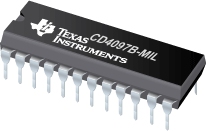

CD4097B-MIL是TI公司的一款模拟多路复用器/多路解复用器产品,CD4097B-MIL是CMOS 模拟多用复用器/多路解复用器,本页介绍了CD4097B-MIL的产品说明、应用、特性等,并给出了与CD4097B-MIL相关的TI元器件型号供参考。
CD4097B-MIL - CMOS 模拟多用复用器/多路解复用器 - 模拟多路复用器/多路解复用器 - 多路复用器/多路解复用器(Mux/Demux) - TI公司(Texas Instruments,德州仪器)
CD4067B and CD4097B CMOS analog multiplexers/demultiplexers* are digitally controlled analog switches having low ON impedance, low OFF leakage current, and internal address decoding. In addition, the ON resistance is relatively constant over the full input-signal range. The CD4067B is a 16-channel multiplexer with four binary control inputs, A, B, C, D, and an inhibit input, arranged so that any combination of the inputs selects one switch.
The CD4097B is a differential 8-channel multiplexer having three binary control inputs, A, B, C, and an inhibit input. The inputs permit selection of one of eight pairs of switches.
A logic "1" present at the inhibit input turns all channels off.
The CD4067B and CD4097B types are supplied in 24-lead hermetic dual-in-line ceramic packages (F3A suffix), 24-lead dual-in-line plastic packages (E suffix), 24-lead small-outline packages (M, M96, and NSR suffixes), and 24-lead thin shrink small-outline packages (P and PWR suffixes).
- Low ON resistance: 125 (typ.) over 15 Vp-p signal-input range for VDD - VSS = 15 V
- High OFF resistance: channel leakage of ±10 pA (typ.) @ VDD - VSS = 10 V
- Matched switch characteristics: RON = 5 (typ.) for VDD - VSS = 15 V
- Very low quiescent power dissipation under all digital-control input and supply conditions: 0.2 uW (typ.) @ VDD - VSS = 10 V
- Binary address decoding on chip
- 5-V, 10-V, and 15-V parametric ratings
- 100% tested for quiescent current at 20 V
- Maximum input current of 1 µA at 18 V over full package-temperature range; 100nA at 18 V and 25°C
- Meets all requirements of JEDEC Tentative Standard No. 13A, "Standard Specifications for Description of 'B' Series CMOS Devices"
- Applications:
- Analog and digital multiplexing and demultiplexing
- A/D and D/A conversion
- Siganl gating
* When these devices are used as demultiplexers, the channel in/out terminals are the outputs and the common out/in terminals are the inputs.







